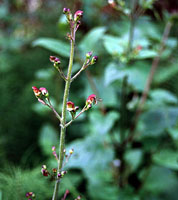Element:FMV
DescriptionFigwort mosaic virus (FMV) is a plant pararetrovirus belonging to the genus Caulimovirus of Caulimoviridae family (International Committee on the Taxonomy of Viruses -ICTV- Fauquet et al. 2005). Although its original host was the flowering plant Scrophularia californica (Scrophulariaceae family), it is also able to infect solanaceous plants (Rollo et al. 1986; Richins et al. 1987). FMV isometric virions are composed of a genomic circular double-stranded DNA of 7743 bp containing four discontinuities, one in the (-) strand and three in the complementary strand. The genome is organized into seven major open reading frames (ORFs) whose size and organization are similar to those of known caulimoviruses (Richins et al. 1987). ORF I encodes a protein of 327 amino acids (aa) associated to cell-to-cell movement (MOV); the ORF II (164 aa) and ORF III (115 aa) predicted products showing sequence similarities with the "aphid transmission factor" (ATF) and "virion associated protein" (VAP), respectively. ORF IV encodes the putative COAT protein and contains the "RNA-binding" motif characteristic of the Caulimoviridae Gag-like domain (C-X-C-X2-C-X4-H-X4-C ) (Bouhida et al. 1993; Hull 1996; Llorens et al 2009). ORF V product is a polyprotein of 666 aa displaying the typical Pol domains -aspartic protease (PR), reverse transcriptase (RT) and RNase H (RH)- while the ORF VI-encoded product of 512 aa is similar to the caulimoviruses-related "Translational transactivator proteins" (TAVs). The small ORF VII immediately precedes ORF I and encodes a 7.4 kDa protein which function is still unknown (Richins et al. 1987). Like other Caulimovirus species (CERV, CaMV, EVCV, LLDAV), two intergenic regions are also present in the genome of FMV: a large intergenic region (LIR) located between ORFs VI (TAV) and VII, and a small intergenic region (SIR) located between ORFs V (Pol) and VI. These regions contain two transcriptional promoter sequences that transcribe whole genome of the virus (that within the LIR) or only the ORF VI (that within the SIR) (Sanger et al. 1990; Bhattacharyya et al. 2002). Structure
Related literature |
|
|||||||||||||||||||||||||||||||||||||||||


